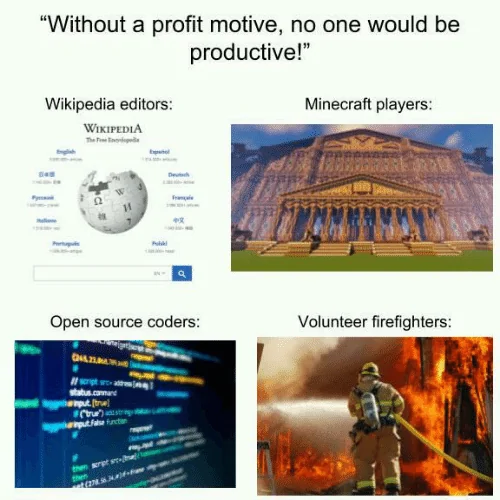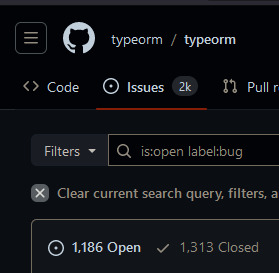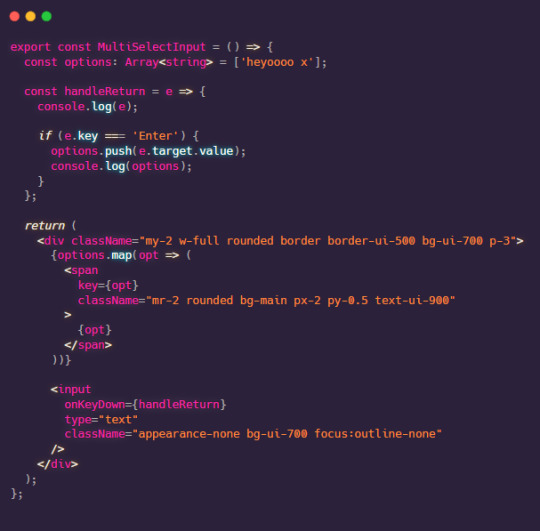#typescript
Text

join praxis now - discord - github
2K notes
·
View notes
Text
Programming pro tip:
Set your IDE's font to Comic Sans to experience what it's like to use JS
89 notes
·
View notes
Text
I finally had some free time due to ✨carnival✨ and deployed the Miss Fisher visualization site that I had only posted screenshots of so you guys can play around with them. I really enjoy seeing them in motion and I hope that you do too! 😊
Some tips of how to use the site:
On the left, select the category of visualizations that you would like to see (the home page is pretty useless as of now hehe)
The legend of each visualization also serves as a filter, so if you click on the box that shows the color of each item you can deselect it from the visualization so that it's easier to see other information inside the graph.
Please open on desktop for a better experience!
There are some new visualizations there that I never posted before, so please check it out! I would love your feedback!
#mfmm#phryne fisher#jack robinson#phrack#miss fisher's murder mysteries#miss fishers murder mysteries#dot williams#hugh collins#datavisualization#data visualization#graphs#angular#typescript
47 notes
·
View notes
Text
TypeScript on the backend is a cardinal sin

How do you see this and go "oh yeah, I want that shit on prod ASAP".
#codeblr#programming#software engineering#progblr#casually spending 5 hours trying to figure out why the delete query builder says it's affecting rows but doesn't do jack#javascript#typescript
84 notes
·
View notes
Text
"8 tips from the TS Wizard" is a fine title for a video, but the title alone highlights the contrast between my social and professional life
35 notes
·
View notes
Text
let today = new Date("12 December 2023");
Hey coders!
The past couple of months I've been a frontend developer intern at an e-sports company and it's been so amazing! I am realizing that yeah, this is exactly what I want to do! I feel super lucky.
Anyway, today, and for the past like week, I have been struggling with implementing the multiselect from react-select in a form we are building in my team. It's a very complicated field, where you can choose from different lists, with values that need to be replaced and disabled depending on which list you are choosing from and what has already been chosen, so just getting the logic right was tough.
Today I got it working, only to realize I can't style it without all the functionality breaking. Feeling like I've tried everything, I was like: you know what? Fuck it, I'm just gonna make my own.
Sooo here I am!
This is the inspo (from react-select):

And this is how far I've gotten(using our on-brand styles):

Anddd here's my (non funcitoning) code:

To break it down:
I have a div that contains a span (which will be rendered from an array of options, to be the yellow chip) and an invisible input field
The div is styled to look like an input field, but in reality it's just a div with spans and an invisible input field following the span (lol special thanks to this stack overflow thread)
When the user types, I am listening to what keys they are pressing with a function I am currently calling handleReturn
If the pressed key is "Enter", I will push the current value of the field to the options array
But! This does not do anything at the moment, since the options array does not tell the component to update itself in any way to display the newly added value! For that, I need to make the options array be a state using the useState() hook from React!
When a state is changed, react's useState can tell, and it will rerender (=update) the component, and then my new value will (...should) be shown as well, since it will be using the new array with new values!
Stay tuned for updates(:
#codeblr#react.js#react#reactjs#frontend#frontend developer#web development#compsci#stem#woman in stem#coding#programming#css#html#javascript#js#software engineering#typescript
17 notes
·
View notes
Text
Has anyone found a way to use both GraphQL Shield and dataloaders at the same time while using Apollo Server and NestJS?
I recently found that because I have asynchronous calls being made in some of my shield rules, it's causing my dataloader batch functions to be called multiple times, when they should only be called once, which leaves me with the N+1 problem across my entire app.
I believe this is due to how dataloader requires that all of the batch function calls occur during the same event loop "tick", and the async calls in my shield rules are preventing this.
Here's where I asked the question on reddit
27 notes
·
View notes
Text
Man, how I wish the language of the web was lua and not js.
Sure it'd probably come to bite me in the ass, I'm sure people behind browsers would find ways to fuck it up.
But there's just something so pure about only having one (one) data structure.
Set? table[value] = true
Map? table[key] = value
List? table[i] = value
Class? table
Iterate? Sure, here's (i)pairs.
It's a little bit like clojure in that - you just iterate. There's no .map or .forEach or any other nonsence.
...plenty of space for me to write my own nonsence, obviously.
This post brought to you by my futile attempts to port my lame little raycaster dungeoncrawler from lua to typescript.
25 notes
·
View notes
Text
Top 8 Most Demanded Programming Languages in 2022 | Resources ✨
A study by DevJobsScanner analyzed more than 7M developer jobs. They concluded the following list to be the most in-demand when it comes to the required languages in the job descriptions!
This is a good starting point/help for those wanting a career in programming!
1. JavaScript + TypeScript
2. Python
3. Java
4. C#
5. PHP
6. C and/or C++
7. Ruby
8. GO

Other languages include SQL, Scala, Kotlin, Dart, Rust & Swift.
Take advantage of this, and have a happy day programming 💻
#coding#programming#computer science#computing#javascript#python#typescript#java#c sharp#php#c programming language#c programming#c++ language#c++ programming#Ruby programming#ruby#GO#GO programming#resource#resources#comp sci#studyblr#studying#backend#computer
214 notes
·
View notes
Text
Application Programming Interface (API)
What is API?
API is the acronym for Application Programming Interface, which is a software intermediary that allows two applications to talk to each other. It is a way for computers to share data or functionality, but computers need some kind of interface to talk to each other.
When you use an application on your mobile phone, the application connects to the Internet and sends data to a server. The server then retrieves that data, interprets it, performs the necessary actions and sends it back to your phone. The application then interprets that data and presents you with the information you wanted in a readable way. This is what an API is - all of this happens via API.
Building Blocks of API
There are three building blocks of an API. These are:
dataset
requests
response
Let’s elaborate these blocks a bit.
An API needs a data source. In most cases, this will be a database like MySQL, MongoDB, or Redis, but it could also be something simpler like a text file or spreadsheet. The API’s data source can usually be updated through the API itself, but it might be updated independently if you want your API to be “read-only”.
An API needs a format for making requests. When a user wants to use an API, they make a “request”. This request usually includes a verb (eg: “GET”, “POST”, “PUT”, or “DELETE”), a path (this looks like a URL), and a payload (eg: form or JSON data). Good APIs offer rules for making these requests in their documentation.
An API needs to return a response. Once the API processes the request and gets or saves data to the data source, it should return a “response”. This response usually includes a status code (eg: “404 - Not Found”, “200 - Okay”, or “500 - Server Error”) and a payload (usually text or JSON data). This response format should also be specified in the documentation of the API so that developers know what to expect when they make a successful request.
Types of API
Open APIs - Also known as Public APIs. These APIs are publicly available and there are no restrictions to access them.
Partner APIs - These APIs are not publicly available, so you need specific rights or licenses to access them.
Internal APIs - Internal or private. These APIs are developed by companies to use in their internal systems. It helps you to enhance the productivity of your teams.
Composite APIs - This type of API combines different data and service APIs.
SOAP - It defines messages in XML format used by web aplications to comunicate with each other.
REST - It makes use of HTTP to GET, POST, PUT or DELETE data. It is basically used to take advantage of the existing data.
JSON-RPC - It uses JSON for data transfer and is a light-weight remote procedural call defining few data structure types.
XML-RPC - It is based on XML and uses HTTP for data transfer. This API is widely used to exchange information between two or more networks.
Features of API
It offers a valuable service (data, function, audience).
It helps you to planabusiness model.
Simple, flexible, quickly adopted.
Managed and measured.
Offers great developer support.
Examples of API
Razorpay API
Google Maps API
Spotify API
Twitter API
Weather API
PayPal API
PayTm API
HubSpot API
Youtube API
Amazon's API
Travel Booking API
Stock Chart API
API Testing Tools
Postman - Postman is a plugin in Google Chrome, and it can be used for testing API services. It is a powerful HTTP client to check web services. For manual or exploratory testing, Postman is a
good choice for testing API.
Ping API - Ping API is API testing tool which allows us to write test script in JavaScript and CoffeeScript to test your APIs. It will enable inspecting the HTTP API call with a complete request and
response data.
VREST - VREST API tool provides an online solution for automated
testing, mocking, automatic recording and specification of
REST/HTTP APIS/RESTful APIs.
When to create an API and when not to
Its very important to remember when to create and when not to create an API. Let’s start with when to create an API…
You want to build a mobile app or desktop app someday
You want to use modern front-end frameworks like React or Angular
You have a data-heavy website that you need to run quickly and load data without a complete refresh
You want to access the same data in many different places or ways (eg: an internal dashboard and a customer-facing web app)
You want to allow customers or partners limited or complete access to your data
You want to upsell your customers on direct API access
Now, when not to create an API…
You just need a landing page or blog as a website
Your application is temporary and not intended to grow or change much
You never intend on expanding to other platforms (eg: mobile, desktop)
You don’t understand the technical implications of building one.
A short 30 second clip to understand it
instagram
Word of advice for newbies
Please don’t wait for people to spoon-feed you with every single resource and teachings because you’re on your own in your learning path. So be wise and learn yourself.
About Me
I am Ishraq Haider Chowdhury from Bangladesh, currently living in Bamberg, Germany. I am a fullstack developer mainly focusing on MERN Stack applications with JavaScript and TypeScript. I have been in this industry for about 9 years and still counting. If you want to find me, here are some of my social links....
Instagram
TikTok
YouTube
Facebook
Twitter
GitHub
#programming#webdevelopment#coding#fullstackdevelopment#appdevelopment#softwaredevelopment#webdeveloper#reactjs#nodejs#vuejs#pythonprogramming#python#javascript#typescript#frontenddevelopment#backenddevelopment#learnprogramming#learn to code#api integration#api#Instagram
179 notes
·
View notes
Text

23 March, 2023 - Tuesday
I must learn Angular, then I started an Alura's* course... discovered that it will be important to know TypeScript... started a TypeScript course. It is like "Inception" film: one thing inside the another 0_o
Let'd go then 彡໒(⊙ᴗ⊙)७彡
*Alura is a Brazilian learning platform, focused on programming.
#studyblr#study#study blog#daily life#dailymotivation#study motivation#study space#studying#productivity#study desk#programming#coding community#programming community#Alura#jack skellington#cute mug#coding girls#typescript#angular#stemblr#computer science#learning how to code
28 notes
·
View notes
Text

join the praxis discord - mastodon - github
#open source#praxis#free software#typescript#foss#graphql#design#collaborative decision making#tech#technology#nodejs#reactjs
550 notes
·
View notes
Text
the desperate, panicky, hair-pulling antics of javascript devs still writing massive optional chains in typescript
like, my dude, you've already confirmed the existential qualities of this object at compile-time, chill out
6 notes
·
View notes
Text
I need to make more programming friends because when I vent to my friends about a function that returns a reference to an object instead of the object itself (like it fucking should), all I get are confused/concerned faces.
In short, JS/TS is a bitch >:(
4 notes
·
View notes
Text
i love using let in javascript/typescript it feels so fancy like yes hmmm i will allow it
13 notes
·
View notes
Text

making cursed js features that shouldn't exist for fun: Array.down() and Array.up(). any method calls between them will apply to all elements of the array.

also works multiple levels deep

loosely inspired by vectorized functions in python
5 notes
·
View notes